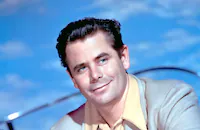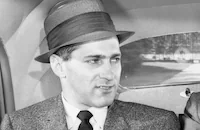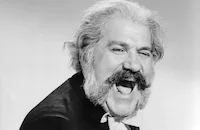The Gazebo

Brief Synopsis
Cast & Crew
George Marshall
Glenn Ford
Debbie Reynolds
Carl Reiner
John Mcgiver
Mabel Albertson
Film Details
Technical Specs

Synopsis
Elliot Nash is frenziedly working as a television writer-director and seeking advances on a new movie script in order to pay off a photographer's assistant named Dan Shelby, who is demanding money to suppress nude modeling shots of Elliot's wife Nell, a Broadway star unaware of her husband's dilemma. One day when his cab injures a pigeon, Elliot insists on rescuing the bird for a pet and naming it Herman. Elliot and Nell return home late that night to find their friend, Harlow Edison, a district attorney, who advises Elliot on his crime writing. Elliot gives him the basic plot for a new story in which an executive is being blackmailed for $10,000 to keep scandalous photographs out of the papers. Harlow assumes that the "executive" is actually Elliot, thus explaining his friend's nervous behavior, and gives Elliot three alternatives: pay the blackmailer, go to the police or kill the blackmailer. The next day, after real estate agent Mrs. Chandler tells Elliot that the McGruders have offered $50,000 in cash for his house, Elliot sabotages the house by loosening door knobs, scrambling the electrical wiring and crossing the plumbing to convince Nell to sell the "faulty" structure. Nell is too excited by her new 18th century gazebo she plans to install in the garden to agree to sell. Soon after he learns from contractor Sam Thorpe that the foundation will set twenty-four hours after it is poured, Elliot decides to kill Shelby and bury him in the foundation. After scheduling a Friday pour, Elliot tells Shelby to come to the Nash home on Thursday night for final payment. On Thursday at the theater, Nell shares her concern about Elliot with Harlow, explaining that she is aware of Elliot's attempts to convince her to sell the house and adds that he has recently bought a shovel, miner's hat and hip boots. Harlow assures her that he must be experimenting with props for a new crime show. Meanwhile, Elliot, following his own typed schedule for the murder, takes a tranquilizer, sets the front door ajar, lays out a tarpaulin to prevent blood stains on the floor and shovels a hole in the foundation's dirt bed. As scheduled, when a man with a briefcase arrives at the front door at 10 p.m., Elliot shoots into the darkened entryway and watches as the body lands on the tarpaulin, but when Elliot tries to move it, the tarpaulin rips, forcing Elliot to retrieve an ugly shower curtain to wrap the body. Noticing the beam of a flashlight outside, Elliot walks into the yard where Thorpe is inspecting the gazebo, notes the hole and leaves with the stray shovel. Before Elliot can return to the house, Mrs. Chandler drops by with the McGruders, who request a tour, but Elliot suggests scheduling one another day. Rushing back to the house, Elliot receives a phone call from director Alfred Hitchcock, who wants an update on the movie script. After Elliot asks Hitchcock how one might bury a body without a shovel, the director suggests using a fireplace shovel. The next day at the house, as rain begins to erode the foundation, Harlow questions Nell about Shelby who, he explains, is blackmailing several prominent women for large sums in exchange for suppressing nude shots of them. Nell admits that she modeled in the nude when she was eighteen-years old, but states that she rebuffed Shelby's blackmail attempts. After Harlow reports that Shelby has been found dead, Elliot realizes that he has shot the wrong person. Finally, when Nell confronts Elliot about the hole and the shovel and guesses that he buried the shower curtains he hated so much, Elliot gladly agrees with her assumption. That afternoon, when Mrs. Chandler drops by with a large cash offer for the home, Nell agrees to sell, explaining in a moment alone with Mrs. Chandler that the gazebo ruined the house's view. That night at the theater, Harlow interrogates Elliot about the night of Shelby's murder and asks if he has a gun. Upon Nell's suggestion, Harlow calls and asks the Nash housekeeper Matilda to locate the gun in Elliot's desk, but Matilda finds only paper. Soon after, the weapon that killed Shelby is found and identified as belonging to Joe Black, Shelby's partner, who killed Shelby and took all the blackmailing profits. Later after the show, gangsters, The Duke and Louis the Louse, abduct Nell and drive her to the house, explaining that Joe was last seen entering her home with $100,000 in a briefcase. Duke and Louis accuse Elliot of killing Joe and threaten to torture Nell if she does not reveal the location of his body. When the gazebo suddenly collapses, the gangsters find Joe buried in the foundation, take the money and leave. Elliot arrives home to discover Nell tied to a chair trying to dial the phone with her nose. Elliot is forced to tell Nell the truth and hides the dead man in the guesthouse. Soon after, the police arrive with Duke and Louis, who indicate where they left the body. Elliot admits to burying the body and is ready to make a statement but then abruptly pleads the Fifth Amendment. Unknown to the police, Herman, who had been perched on a bookshelf, directed Elliot's attention to a bullet hole in a book. While the police search the ground for Joe's body, Elliot explains to Nell that his shot did not hit Joe and deduces that the blackmailer died of a heart attack. Assuming that if the police find the bullet, Elliot will be accused of frightening Joe to death, Elliot and Nell frantically search for it, but Herman finds it first and flies off. The police conclude that they can only charge Elliot with burying a body without a permit and walk out the front door, where Herman drops the bullet on an officer's hat. Believing that the bird defecated on him, the officer discards his hat in the yard, thus ensuring Elliot's freedom.

Director

George Marshall
Cast

Glenn Ford

Debbie Reynolds

Carl Reiner

John Mcgiver

Mabel Albertson
Doro Merande
Bert Freed

Martin Landau

Robert Ellenstein
Richard Wessell
Herman, The Pigeon

Harlan Warde
Stanley Adams
Michael Dugan
Ken Wales
Peter Ford
Helen Kleeb

Jack Kruschen
Rex Lease
Owen Mcgiveney
Frank Mitchell
James Gavin
Jon Lormer
Michael Johnson
John Mckee
Franklyn Farnum
Harvey Parry
Bill Smith
Pat Blair
Guy Stockwell
Jimmy Hayes
Mark Houston
Gene Coogan
Crew
Jeff Alexander
George W. Davis
Walton Farrar
Adrienne Fazan
Henry Grace
Paul Groesse
Sydney Guilaroff
Kurt Hernfeld
Robert R. Hoag
Walter Kent
Franklin M. Milton
Robert Priestley
Alex Romero
Helen Rose
Erich Von Stroheim Jr.
William Tuttle
Paul C. Vogel
Lawrence Weingarten
George Wells

Photo Collections
Videos
Movie Clip


Trailer
Hosted Intro
Film Details
Technical Specs

Award Nominations
Best Costume Design
Articles
The Gazebo
The Gazebo was the second teaming of Ford and Reynolds, who had struck romantic sparks both on and off the screen earlier that same year in It Started with a Kiss. In fact, 1959 was a year of nonstop work for Debbie Reynolds - she had four films released that year, also appearing in The Mating Game and Say One for Me. It was also a turbulent year in her private life. The very public breakup of her marriage to crooner Eddie Fisher, due to his affair with the recently widowed Elizabeth Taylor and his abandonment of Reynolds and their two young children, grabbed worldwide headlines for months. Ford's marriage to dancer Eleanor Powell had also recently broken up, and the two commiserated and helped console each other. According to Reynolds' autobiography, Ford even proposed to her, but she wasn't ready to get serious again so soon. She and Ford remained lifelong friends instead, although they never again made another film together.
Ford had been a movie star for two decades; in 1958, he was voted the number one box office attraction but had mostly appeared only in dramas and westerns. Several critics praised Ford's comedy skills in The Gazebo. "This film is nearly all Ford, and he's up to every scene, earning both sympathy and laughs as he muddles through his farcical 'crime,'" wrote the Variety critic. But Bosley Crowther of the New York Times disagreed. "Perhaps if Mr. Ford were a better, or at least a less wooden comedian than he is, some of this blundering and blathering would seem a little brighter than it does....But we're afraid Mr. Ford hasn't got it. He is not a comedian." Fans apparently disagreed. Ford's two comedies with Reynolds opened up a whole new career path for him, and his low-key charm would grace some very successful comedies of the early 1960s, including Pocketful of Miracles (1961) and The Courtship of Eddie's Father (1963).
Reynolds didn't have much to do in The Gazebo but wear Helen Rose's Oscar-nominated costumes. But the supporting cast was filled with some superb comic character actors, including Carl Reiner, John McGiver, Bert Freed, and Doro Merande. Martin Landau, who was playing a lot of gangsters during this period, did so again, very well, in The Gazebo. And, of course, there was that well trained pigeon, Herman, showing a lot of star quality. The Variety review summed up the film aptly: "Cheerful murder-can-be-fun comedy....Good b.o."
Director: George Marshall
Producer: Lawrence Weingarten
Screenplay: George Wells, based on a play by Alec Coppel, from a story by Myra & Alec Coppel
Cinematography: Paul C. Vogel
Editor: Adrienne Fazan
Costume Design: Helen Rose
Art Direction: George W. Davis, Paul Groesse
Music: Jeff Alexander
Cast: Glenn Ford (Elliot Nash), Debbie Reynolds (Nell Nash), Carl Reiner (Harlow Edison), John McGiver (Sam Thorpe), Mabel Albertson (Mrs. Chandler), Doro Merande (Matilda), Martin Landau (The Duke).
BW-102m. Letterboxed. Closed Captioning.
by Margarita Landazuri

The Gazebo
Quotes
Trivia
Notes
The opening credits for film begin: "Metro-Goldwyn-Mayer presents Glenn Ford Debbie Reynolds a Avon Production The Gazebo." According to a January 19, 1959 Los Angeles Examiner article, Frederick Brisson, who is credited onscreen as "presenting" The Gazebo on stage, sold the play to M-G-M in 1959. Although James Kirkwood and ZaSu Pitts are listed in Hollywood Reporter productions charts for the film and modern sources list them as the "McGruders," the actors were not in the released film and the characters are only discussed, not seen.
A September 2, 1959 Hollywood Reporter news item adds Sonny Howe, Carey Leverette, Paul Reese and Mevrisse Duree to the cast, but their appearance in the final film has not been confirmed. Actor Peter Ford, son of Glenn Ford and his former wife, dancer-actress Eleanor Powell, made his film debut as a page boy in the film. Television actor Carl Reiner also made his film debut in The Gazebo. Although famed director Alfred Hitchcock was mentioned in the story, he was not seen or heard in the film.
The Gazebo opened in Los Angeles the week of December 19, 1959 in order to qualify for the 1959 Academy Awards. The film received an Academy Award nomination for Best Costume Design (black and white), but lost to Some Like It Hot. A French film version of Alec Coppel's play was released in 1971 under the title Jo, directed by Jean Girault and starring Louis De Funès and Claude Gensac.

Miscellaneous Notes
Released in United States Winter January 1960
Alfred Hitchcock was the voice on the phone telling Glenn Ford how to dispose of the body.
Scope
Released in United States Winter January 1960
















